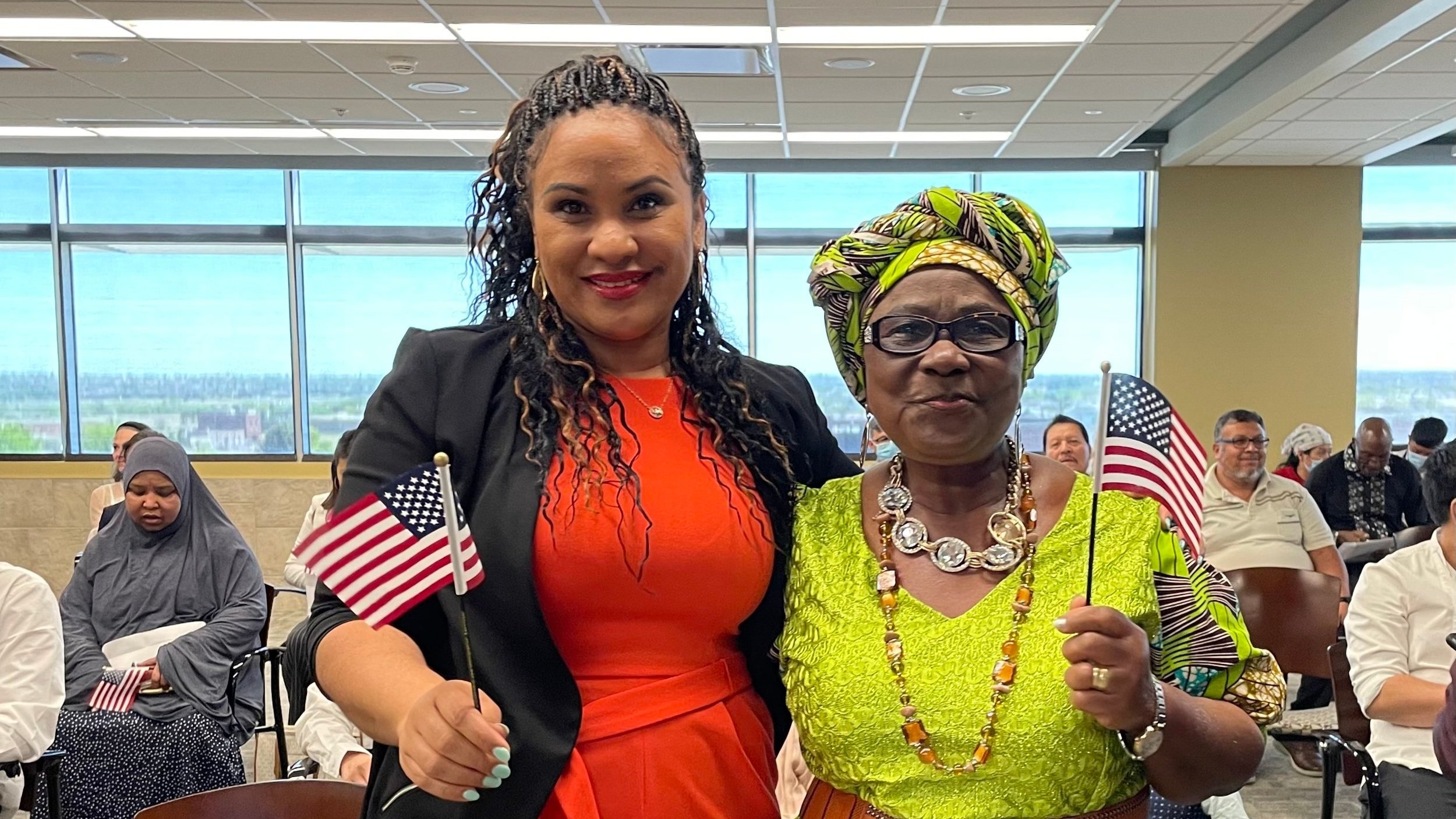How a listening-focused reporting process shaped season 2 of KUNC’s ‘The Colorado Dream’ on the Black immigrant experience
New U.S. citizens Salwa Mourtada Bamba and her mom, Martha Annette Potter Mourtada, hold American flags after their naturalization ceremony in May, 2022. | Credit: Stephanie Daniel / KUNC
Colorado has the fastest-growing Black immigrant population in the country. That’s the focus of season two of KUNC’s podcast “The Colorado Dream,” Hosted by Stephanie Daniel. She spent months listening and building trust with Black immigrants in the Colorado city of Aurora, which has one of the largest immigrant populations in the state. Now that the season has wrapped up, she’s bringing the conversation back to Aurora with live events and listening sessions. Daniel told us how her reporting came together and how the conversations she had without microphones shaped the season.
Tell us who you are, and share a brief summary of the reporting project?
I’m Stephanie Daniel, a senior managing editor and reporter with KUNC. I also host a KUNC podcast called “The Colorado Dream” which shares the stories of Coloradans who are overcoming obstacles to create a better life for themselves and their families in an effort to achieve the American Dream.
Season two of the podcast explores the Black immigrant experience in Aurora, where about one in five residents is foreign-born. The series is told through the eyes of an immigrant from Liberia, local leaders, and residents as the city strives to become an inclusive home for all.
How did community engagement inform your reporting?
The Black immigrant population in Colorado is growing faster than anywhere else in the U.S. Those that have settled in Aurora come from Africa, the Caribbean and beyond — and they all have their own unique stories. So I knew it was important to listen to them — and their communities — before and during the reporting process. This started with my main source, Salwa Mourtada Bamba, an immigrant from Liberia. I initially heard about her from a press release sent by the nursing school she was attending. The first time we met, I didn’t interview her, we just chatted for over an hour and got to know each other. I learned about her background and told her about my vision for the podcast. From there, I started interviewing her and we met over a dozen times.
To support foreign-born residents, Aurora created an ambitious immigrant integration plan which was an integral part of my reporting process and the podcast. To learn more about the plan and the issues facing immigrants, I had several introductory conversations with the city which led me to local organizations. After more informal conversations, I met and interviewed more than two dozen immigrants and refugees and some of their stories became the backbone of the series.
When I began working on the podcast, I had two starting points: the city of Aurora and Black immigrants and refugees. I let my conversations and interviews with both groups inform my reporting and the direction and themes of the series.
How did you build trust in the community you were reporting on?
I talked and I listened. When appropriate, I talked to people about the podcast, my reporting and the topics I hoped to cover (my primary goal wasn’t to find sources but spread awareness about the work and spark conversation). Also, I listened when sources recommended I talk to someone else or suggested a lead to follow-up. Here are two examples:
First, I was covering an International Women’s Day event at the State Capitol that was hosted by a state representative who is the first Black immigrant to serve (she was also a source). While waiting for a program to start, I chatted with an African American woman about the podcast. Turns out she’s married to an immigrant from the Democratic Republic of Congo. I saw her again the following week at another event I was covering for the podcast and subsequently, ended up interviewing her and husband. They are featured in episode four, “identity,” which examines the relationship between African immigrants and African Americans.Their interview is what prompted me to do more in-depth reporting on the complicated relationship between the two groups.
Second, I planned to cover a recent state law that provides free legal assistance for people facing deportation in the podcast. During an interview with a woman who works for an organization that co-sponsored the legislation, she suggested I talk to another expert who is also the child of East African immigrants. When I spoke to the expert he connected me with an African immigrant who founded a non-profit that worked with vulnerable populations in Aurora. My interviews with all three became integral to how I reported and wrote episode five.
How are you bringing this reporting back to the community?
A week after the final episode aired (was released), KUNC hosted a free community event and panel discussion in Aurora to talk about the themes explored in the podcast. I invited all my sources to attend and asked them to extend an invitation to their communities. In addition, we reached out to other groups and promoted the event on-air and over social media. The event was also live-streamed on Facebook to reach a broader audience.
What lessons do you take away from this project in terms of strengthening your engagement?
It’s really important to talk to and listen to the communities that we cover. While working on the podcast, a lot of my sources told me to go talk to “this other person” and I always followed up on that lead. I think it showed them that I was listening and was committed to looking into the issues they had identified and the topics that mattered most to them.


